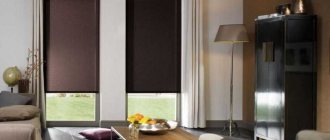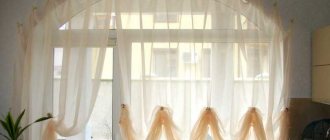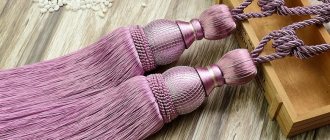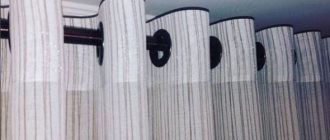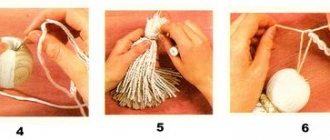Curtains with fringe are a symbol of luxury and wealth, which are used to decorate window openings in all classic interiors. Curtains decorated with decorative braid are the highlight of the room; they attract the eye and focus on the thoughtful design of the room.
Curtains with fringes
From this article you will learn what fringe for curtains is and how to use it correctly. We will consider the main types of decorative products and provide recommendations for their selection and sewing technology.
how to sew fringe
how to sew on fringe
And how to sew on fringe correctly, you will learn from this master class.
At the very end of this article you can watch a video tutorial that shows an alternative way to process a square tablecloth with fringe.
We can process the piece with fringe in two ways.
1st method:
And so, we have a cut out part and a fringe
Overcast the edge of the piece, turning it wrong side up
We apply fringe to the front side of the part and machine stitch it to the edge of the upper side of the fringe:
If the fringe is wide, then at some distance from the first line, we lay the second
View from the inside
Method 2:
We have a cut out part and a fringe:
We apply the fringe to the wrong side of the cut piece and machine stitch along the bottom edge of the fringe like this:
Here's what happened:
<<<SUBSCRIBE TO NEW ARTICLES OF THE SITE>>>
We turn the stitched fringe over onto the face of the part and secure it along the upper edge of the fringe with a machine stitch:
That's it, our fringe is sewn on.
Here's what came out of the face of the part:
And this is a view from the inside of the part:
If we need to decorate our lambrequin not only with fringe, but also with a tassel, then we can make a tassel from fringe.
And so let's get started. Cut a piece of 10 centimeters from the fringe. Pull out a thread from it:
Now we put a piece of our fringe on a piece of unnecessary fabric (the glue will seep through), and coat the braid with glue. I do this with a simple Moment:
We put our pulled thread into the fringe braid coated with glue, and roll up the braid along with our thread (our tassel will hang on it):
Now we wrap the second thread several times around the rolled up fringe braid and secure the knot:
That’s it, our tassel is ready, you can hang it on the part of the lambrequin where this decoration is required:
You can also learn how to make these brushes yourself:
To do this, see the master class: “How to make a brush for curtains with your own hands.”
And now the promised video lesson:
The free video course “I Sew Myself” will help you learn how to sew for yourself and your loved ones.
To get the course, click on the picture:
Sew on
Before we begin, let’s take a look around to make sure everything is ready for the process:
- fringe braid;
- threads, needles;
- scissors, matches;
- sewing machine that performs straight stitch, zigzag;
- the curtain itself.
Step 1. In the case of a raw edge of the curtain, it can be overlocked or simply burned with matches to prevent threads from “spraying”.
Step 2. To prevent the material from pulling together, you need to place the fabric on top of the braid. In this case, the fringe is placed wrong side up, with the decorative layer facing left. The fabric is face up on top. Let's make the first line. The fabric will stretch with the foot, and the braid, on the contrary, will shrink.
Step 3. Turn the fringe to the front side and make a second line. If it is difficult to make an even seam, you can pre-baste the lapel.
Step 4. Having reached the edge of the canvas, cut off the required amount of braid, taking into account 2-3 cm per hem. The edge of the fringe is burned, folded from the face to the wrong side of the fabric and sewn on.
Step 5. The laid lines are steamed from the inside out. If you use embossed fringe, you need to place something soft underneath, for example a towel folded several times.
Tip: when sewing on fringe, the edge of which is decorated with glass beads or beads, use a single-sided foot for sewing.
Source: perlanta.ru
Decorating curtains: brief description, types of decorations
Gone are the days when curtains were used only to hide from prying eyes. Today, a variety of drapes, curtains and blinds are used to decorate a house or apartment, as an addition to the overall interior decoration. Therefore, the question of decorating curtains is very, very relevant. With a little imagination and patience you can get amazing results. The range of matching accessories available today (beads, appliques, chains and tassels) will help with this.
With the help of decoration you can effectively change the appearance of any curtains
One of the decoration options is a three-dimensional applique on the canvas. It seems that nothing can look more boring than simple white curtains. As you can see in the photo, if desired, they can be turned into a real masterpiece. Large flowers, made of the same fabric as the curtain itself, can be decorated with imitation pearls or sequins.
Vintage lambrequin decorated with brass rivets
Another example of adding appliqué to curtains. In combination with metal rivets and made in the right color scheme, this option is appropriate for a country house or cottage.
Jabot is one of the most popular elements to complement the design of curtains. It is a piece of fabric with a beveled edge, which is placed on the side of the lambrequin. As a rule, the jabot is made of fabric of the same color as the curtains. A prerequisite for a jabot is that it must drape well.
Jabot (or de jabot) - a lambrequin detail located on the sides
Classic style curtains are decorated using molds. This is one of the elements of the lambrequin, which is an insert with vertical drapery. It can contrast with the main design or be the same color as it. It looks somewhat pompous, but in a room with high ceilings it is quite appropriate.
A mold made of double folds laid behind each other
Perhaps the most common and affordable decoration for curtains is a decorative holder. This element can be of different shapes and from different materials. It can be used for its intended purpose, or solely as decoration (for example, the photo shows holders located on the hinges of the curtain).
An unusual way to secure a curtain
Tassels and fringe also do not lose their relevance, despite the changing times and fashion trends. Although their main stylistic direction is classic, they feel quite comfortable in modern trends.
Fringe for curtains: description, instructions and diagrams for DIY finishing
Until relatively recently, fringe was a simple braid that had a straight edge on one side and loose threads on the other. Today, the variety of fringes can be surprising. Not only are there many colors available, but also a range of different configurations and combinations.
Fringe serves as an effective decoration for curtains in various styles.
There are four types of fringe:
- split;
- block;
- tinsel;
- fan-shaped
Fringe with additions (inserts) made of plastic, wood or bamboo is becoming increasingly popular. Curtains with pom-poms are also in demand.
The decor can combine several colors and textures. And so that all this splendor does not look vulgar and rude, it is important to correctly combine curtain fabric and braid. In this option, finishing the curtains with braid with bells would look appropriate.
Fringe to match the fabric will decorate the curtain, but will not be conspicuous
For heavy fabric, massive fringe is suitable. And if the curtains are light and airy, then the decoration should be weightless.
It just seems like sewing on fringe yourself is the easiest task in the world. If this work is done incorrectly, the curtains can be hopelessly damaged. Therefore, you need to be patient and make every effort.
- First, you need to decide where the fringe will be sewn. This is usually the bottom cut or side edge.
- Now we process the edge of the curtain (stitch or burn it).
To prevent the fringe from unraveling after sewing, we burn the edges - Then we place the braid under the fabric (the fabric is placed inside out) and sew.
If the braid is wide, make two lines, moving away from the edges - Now we sew a line along the front side of the curtain, at the very top of the braid.
After the front stitch, we bend the ends of the fringe to the wrong side and hem them with two lines
A curtain designed in this way will not “wrinkle” or stretch at the place where the fringe is attached.
Important! Fringe is used not only for decorating curtains. It is actively used for finishing pillows and bedspreads, tablecloths, as well as for decorating upholstered furniture.
Conclusion
Fringe is one of the most popular and affordable methods of decorating curtains. It is recommended to select fittings to match the color of the main panels; contrasting options are used only in special cases. At the same time, a clear match of shades is not encouraged; there should be a slight discrepancy that will emphasize the color of the material. When decorating rectangular, simple-shaped fabrics, fringe is sewn only on the lower part of the curtains. Diagonal options with tiebacks will look more attractive with fittings also placed along the edge of the canvas.
Source: dekormyhome.ru
Tassels on curtains: examples of interior design
The 17th century is considered the golden age of brushes. It was then that this element began to be used for interior design and for decorating clothes, shoes and accessories. Today, tassels are getting their rebirth, and while they are not used so often in clothing, they are more than in demand for decorating curtains.
Typically, these accessories are used to decorate tiebacks and lambrequins.
Most often, this element is used for finishing lambrequins or curtain holders. They can be made from natural or synthetic threads, complemented with beads and chains, and decorated with fabric.
Brushes can be of various shapes and thicknesses
Color scheme may vary:
- same shade as the canvas;
- obvious contrast.
The simplest curtains will look luxurious if complemented with tassels of the right color scheme.
Multi-colored curtains with tassels matched to fabric tones
Even Roman blinds, which look quite self-sufficient, are decorated with tassels. This makes the room stylish and very cozy. This decor would be appropriate not only for a kitchen window (photo), but also for a nursery or bedroom.
If you attach the tassels to the lower edge of the Roman blind, they will decorate the curtain even when folded
Brushes are used as holders in different ways:
- Two different cords, decorated with tassels, wrap around the canvas and are connected to each other with a knot.
- Macrame. Delicate weaving is appropriate for both light tulle and textured curtains.
- The asymmetrical “pickup” of the curtains visually increases the space. One canvas is attached at the level of the window sill, and the second - higher.
There are several ways to attach tassels to curtains. They can be attached to the main curtain fabric. Alternatively, they can be sewn around the entire perimeter of the curtain. Finally, this element is attached to the cords that will support the canvas. To complete the interior, the same tassels can be sewn to sofa cushions or a bedspread.
Important little things
You need to match the fringe to the main curtain fabric. The best thing is to come to the store with it and apply the braid options on the spot, choosing the best combination.
Do not forget about the ratio of the weight of the braid and the fabric so that, in the end, the fringe does not look like “weights” on a light fabric. At the same time, take into account the general style of the room.
If you use several types of fabrics to decorate your window, then the fringe for them must be selected separately so that it matches the texture and type of fabric.
To give the interior a touch of romanticism and fairytale, use braid with glass beads, rhinestones and pendants made of beads and balls.
If you purchase multi-colored fringe, select threads for sewing on several colors. It is best to use two colors that dominate the color scheme.
When deciding on the required length of the braid, calculate it with the reserve that will be used for tightening.
Lambrequin with fringe for curtains: how to make, instructions for sewing a lambrequin with fringe, photo
Lambrequin is one of the most popular elements for window decoration. Thanks to it, the design of the curtains gets a finished and elegant look. And if initially it was created in order to hide the place where the curtains were attached to the cornice, today it is a completely independent decorative design detail.
Lambrequin can be of different types and shapes:
- Simple.
A sheet of fabric attached to a curtain tape. Simple lambrequin with gathering on curtain tape - Soft.
The fabric for this should be lighter and drapery well. Soft lambrequin on the doorway - Hard.
The special frame is covered with curtain fabric. Rigid lambrequin on a plywood frame - Combined.
Combined lambrequin with decorative gilding - Fan or shell.
Lambrequin fan with decorative tassels
Almost every type of lambrequin is decorated with fringe or tassels.
Only an experienced craftswoman can make a lambrequin with her own hands. This work requires certain skills, perseverance and careful adherence to all specified proportions and sizes. Since the design is multi-layered, each element should complement the composition, and not “argue” with it, standing out against the general background.
This is what an approximate diagram of a lambrequin for a standard window looks like. One of the most popular options has been selected.
Curtain pattern with lambrequin
Before you begin, you need to calculate the required amount of fabric. The length and width of the fabric should be selected taking into account seam allowances.
To make a swag, a rectangular fabric is taken, marks are made on it to create drapery, then the resulting folds are secured with stitches.
Pattern diagram for a symmetrical swag
Formation of swag folds
Having made all the swags, they are attached to a special curtain tape. When the upper part of the lambrequin is ready, form a tie - the side part. It can be one-sided or double-sided, located only on the sides or decorate the central part of the structure - there are enough options.
Classic tie pattern
When all the parts are ready, they are also secured to the curtain tape with a stitch. Typically, the final stage of creating a lambrequin is finishing with fringe or tassels.
The fringe is hemmed on the wrong side of the lambrequin
Design options and examples of decorating curtains with fringes and tassels, photos
Blue curtain with gold patterns
Blue velvet curtains are harmoniously complemented with golden braid with small tassels and decorated with large tassels. The combination of blue and gold gives the interior an official and solemn look, and the tassels emphasize the sophistication of the classic style.
Spectacular curtains for the kitchen-living room
In this case, a bold color scheme and combination was chosen. In the photo, checkered curtains, decorated on loops with voluminous flowers, are complemented by fringe and tassels made of the same material. The color of the cornice matches the overall picture of the interior.
Tassels with fringe on a canopy decorating a luxurious bed in an elegant bedroom
When a variety of volumetric tassels are preferred, it is important to choose the right curtain fabric and interior decoration. The same brushes should be on pieces of furniture and accessories: pillows, bedspreads.
Brushes and fringes are real masterpieces of interior art. They are able to decorate curtains in any style and make the interior unique, adding an element of luxury to everyday gray days.
Decor selection
Fringe is a type of decorative braid with laces, threads or any other pendants hanging from one side.
Traditionally it is sewn onto the bottom edge of curtains. But recently it has become fashionable to deviate from tradition, and more and more often you can find curtain models with fringes sewn at 2/3 of their height or with stripes at the same distance from each other. It can be colored or plain, natural or synthetic.
The braid (base) can also be very different - from a simple thick ribbon to openwork lace. To decorate curtains, 4 types of fringe are used:
- 1 Split - with an evenly cut straight edge.
- 2 Tinsel - with fluffed or twisted decorative threads.
- 3 Block - consisting of colored segments. They can be made in different shades of the same color scheme or contrasting ones.
- 4 Fan - with textured edges cut in the shape of a wave or scallops. Its base can also be figured - wavy or cascading.
The photo shows options for finishing fringed curtains with a rigid lambrequin.
In addition to fabric threads and strands, there are a huge number of elements that make up fringe: threads made of beads and glass beads or any other metal, wooden or plastic fittings, as well as tassels, bells and pompoms
Peculiarities
Fringe is considered to be curtain braid with hanging threads or pendants. It is used in the decoration of window space to give it solemnity. Very often this braid is heavy, which is why it is used for finishing massive curtains. Modern industry also produces special lightweight weaving braid, which can be used to decorate light curtains.
Textiles with tassels are used to decorate:
- curtain panels on the sides;
- bottom edge of the curtain;
- lambrequin;
- pick-ups.
The textile industry produces a huge amount of braid with thread edges. It is painted in different colors, made from a variety of materials, it can be plain or variegated, twisted or straight.
Depending on the material used, fringe can be:
- thread - a classic version of the product, looks like braid with tall threads;
- with tassels - the edge of the braid is trimmed not only with threads, but also with tassels;
- with pompoms - braid with balls in the form of pompoms;
- with pendants - with shells, rhinestones, beads and beads, plastic products;
- from cords;
- with bugles - with hanging shiny stones.
Despite the similarity of the product with the name, fringe can be divided into several groups:
- split - the hanging threads are cut along the edge, due to which it has a smooth edge;
- block - the product consists of multi-colored blocks, each of which differs in shade, texture or material;
- tinsel - has in common with the split one, the difference is that the decorative threads are twisted and attached to the heads like tassels;
- fan - the edge of the braid has scallops and curly cutouts.
Products are divided depending on what they are intended for:
- decorative braid used to trim a lambrequin or other curtain fastening;
- small tassels that are attached to the edge of the curtain;
- tiebacks made of woven cords.
The use of fringe in finishing curtains performs certain tasks:
- the monotonous pattern on the curtain material, as well as its complete absence, can be diluted by sewing on decorative braid;
- with the help of such braid you can strengthen and secure the drapery;
- beautiful fringe will highlight the colors of the fabric or create a festive mood. Depending on the desired effect, this element is selected to match the curtains or in contrast to them. The braid, chosen to match the prevailing palette, will create an atmosphere of integrity;
- braid with small tassels sewn along the bottom edge of the curtains visually stretches the curtain and at the same time eliminates wrinkles;
- finishing in this way gives the curtains a solemn look and highlights the window opening.
- fringe for curtains in some cases helps to hide unevenness or unsightly seams.
Decorating curtains with fringe is typical for different styles, but you can especially often find it in classic and oriental interiors. Metallic braid fits perfectly with chromed metal cornices in high-tech style. Curtains in Country style are often decorated with lace fringe made of cotton, and in a nursery, ribbons with plastic fish or shells in sea green color or with bells would be appropriate.
Fringe decor is possible in different styles:
The only thing that is contraindicated for this textile product is Minimalism.
Design
Initially, fringe was associated with the interiors of the Middle East and luxurious apartments.
The photo shows design options for curtains with fringes for a children's room.
Today its assortment has been enriched with new varieties that are far from the classics. Modern varieties of this curtain accessory adapt to most interior styles and are used not only in the living room or bedroom, but also in other rooms.
Glass beads or metal threads look great on chrome cornices in high-tech and avant-garde interiors. Lace braid and fringe made of pompoms and tassels are appropriate on wooden cornices and combine with country and shabby chic styles. Curtains with threads of small shells and plastic fish can be hung on plastic curtain rods and become a highlight of the Mediterranean interior.
Harnesses and tassels will make expensive curtains even more glamorous, while pom-poms and glass beads will add naivety to budget curtains. A classic fringe made from strands is suitable for the living room, small pom-poms for the nursery, and neat tassels for the kitchen.
To prevent fringe from seeming like a foreign element, when choosing it you need to take into account not only the style of the interior, but also the texture of the fabric and the model of the curtains themselves. Since this decoration is self-sufficient, both the cut of the curtains and their colors should be simple.
Ideally, these are even pieces of fabric, plain or with a small and dim print. And, of course, it is permissible to decorate only curtains made of artificial fabrics with fringes made of synthetic materials.
Heavy tassels and dense strands are suitable for equally heavy and dense curtains made of velvet, jacquard, and satin. For thin organza, silk or translucent cotton, it is better to choose something equally light and airy: glass beads, pom-poms, small tassels.
Curtains with fringe attract the eye and speak of the good taste of the owners of the room. It’s not for nothing that designers are increasingly adopting it and actively using this curtain accessory to embody a variety of stylistic ideas. Try decorating curtains with fringe in at least one room. The result will definitely please you.
Popular posts
- What are curtains chosen for? How to choose the right curtains for the living room - basic tips and recommendations In the interior of the living room, curtains...
- Curtains in a bay window Curtains for a bay window - a collection of elegant solutions 15,985 customer reviews choose us Prices are lower! due to...
- Curtains for the terrace Roller blinds for the gazebo in Russia Do you need clients? To add products and services to...
- Screwdriver for self-tapping screws Attachment for a screwdriver with automatic supply of screws A screwdriver is an indispensable thing in the arsenal of a home craftsman. However…



